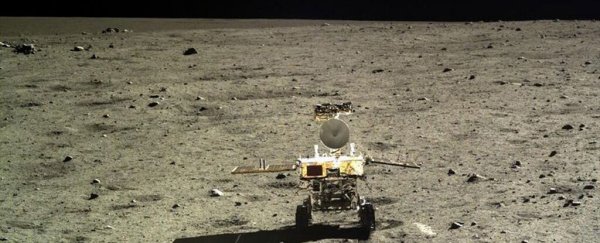In what will be a first for science, China has announced its intention to land a probe on the dark side of the Moon, exploring lunar territory that has never been seen up close by human eyes.
The new mission will see China's Chang'e-4 probe investigate the dark side of the Moon in 2018, according to a report by Xinhua, the state-run news agency. While the dark side of the Moon has been observed from orbit and photographed (not to mention sensationally GIF'd), it's never been explored by human astronauts nor landed upon by spacecraft.
The dark side is so-called because it always faces away from Earth due to gravitational forces, with the 'dark' in the name historically imputing that we can't see or understand it, rather than it actually being physically dark. But that meaning will become even more anachronistic soon, with China's mission set to bring us into direct contact with the Moon's most mysterious territory.
"The Chang'e-4's lander and rover will make a soft landing on the back side of the Moon, and will carry out in-place and patrolling surveys," Liu Jizhong, China's lunar exploration chief, told the press.
China's swiftly developing space program initially replicated feats already achieved by the US and others, but this latest mission provides growing evidence that in recent years the nation has become serious about setting records of its own.
"The implementation of the Chang'e-4 mission has helped our country make the leap from following to leading in the field of lunar exploration," said Liu.
Chang'e-4 will follows China's successful Chang'e-3 mission, which soft-landed on the Moon in 2013, becoming the first spacecraft to do so in almost 40 years (and which has turned up things about the Moon we never knew, and the mission is still giving us new data).
After Chang'e-4, an upcoming Chang'e-5 craft now being developed will be the star of an even more ambitious mission – landing on the Moon and then returning to Earth.
According to Liu, the Chang'e-4 probe is very similar to Chang'e-3 in structure but can handle a larger payload. The spacecraft – and any rover it contains – will study geological conditions of the dark side of the Moon.
This research could tell us all sorts of new things about the Moon, in particular bringing the possibility of exploring the lunar surface in the South Pole-Aitken basin. One of the largest known impact craters in the Solar System, this gigantic hole may feature exposed mantle materials, according to Clive Neal of the Lunar Exploration Analysis Group, which is affiliated with NASA.
"There has been no surface exploration of the far side," he told AFP. "I am sure the international lunar science community will be very excited about this mission. I know I am."
Update: We received a lot of feedback in relation to the original headline this story featured, which used the term "dark side of the Moon". As the article explains, that name historically means "dark" as in "unknown", since because that side of the Moon faces away from Earth, for a long time humanity was unable to see it or study it. It does not mean "dark" as in physically dark and receiving no light. In the interests of clarity, we have changed the headline to "far side of the Moon".
